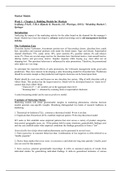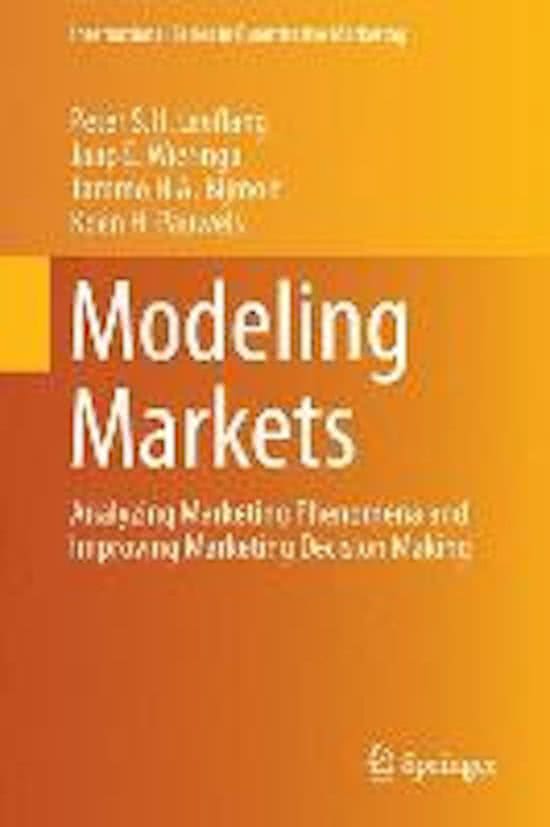Market Models
Week 1 – Chapter 1: Building Models for Markets
Leeflang, P.S.H., T.H.A. Bijmolt, K. Pauwels, J.E. Wieringa, (2015), “Modeling Markets",
Springer
Introduction
Analyzing the impact of the marketing activity for the other brand on the demand for the manager’s
brand. Models have been developed to advance market knowledge and to aid management decision
making.
The Verhouten Case
Chocolate factory Verhouten. Assortment consists now of four product classes: chocolate bars, candy
bars, specialties and seasonal products sold under the brand names Tiger and Dream. Supermarket
channel distributes 75%, candy stores 10%, sport canteens 8%, gasoline stations 4% and tobacco
stores 3%. There are several usage motives for chocolate bars: functional motive, treat-oneself motive,
sharing motive and give-away motive. Impulse response while buying (e.g. most often not on
shopping list). This purchase behaviour is influenced by sales promotions. Therefore, the promotional
sales spikes are very large.
To anticipate the expected effects of sales promotions, the Verhouten management needs good sales
predictions. Thus, have interest in developing a sales forecasting model for chocolate bars. Predictions
should be accurate enough so that production and logistic decisions can be based upon them.
Model should be a test case and focuses on one chocolate bar variety; 100g of milk chocolate sold at
Albert Heijn. This product has the largest turnover. Model will be developed based on “chain level”
scanner data from Albert Heijn.
“Chain-level” >> all variables are at the aggregate chain level
“Scanning data” >> obtained by scanning items at supermarket checkouts
A sales forecasting model can be seen as predictive model.
Typologies of Marketing Models
Marketing models will create generalizable insights in marketing phenomena, whereas decision
models generate case-specific insights. Ehrenberg distinguished two kinds of research traditions in
marketing:
1. Theoretical-in-Isolation (TiL); construct a theoretical model test it on data
2. Empirical-then-Theoretical (EtT); establish empirical pattern develop theoretical model
EtT seeks to first establish some empirical patterns that exist across a variety of product categories,
time period, geographic areas, etc. If this pattern hold in many situations, generalizable findings exist
and one can establish under what empirical conditions the findings generalize to form a “law”.
Generalizable knowledge about market phenomena can be generated in several ways.
1. Find regularities in customer behaviour data. Combinations of two negatives is often referred to as
“double jeopardy”
2, Derive from studies that cover many circumstances and relatively long time periods. Usually panel
data are used for that purpose.
3. Meta analyses generate generalizable knowledge. It refers to statistical analysis of results from
individual studies for generalizing individual findings. It delivers generalized estimates of various
,elasticities, quantitative characteristics of buyer behaviour, and an assessment of the moderators
related to the empirical and study context affecting these estimates.
Implicit Models
It is often said that managers approach problems in an intuitively appealing manner. The decisions
makers have implicitly made use of a model. However, this model is not necessarily recorded in a
communicable form; it is an implicit model which so far is present only in the brain of the decision
makers
Verbal Models
First step in making a model explicit is for a manager to state in words what she/he perceives at the
important elements surrounding a problem.
Formalized Models
To make relationships more precise, it is necessary to formalize them. We specify which variables
influence which other variables and what the directions of causality between these variables are. This
is called a formalized model which can be further divided into
1. a logical flow model which shows the sequence of questions and actions by the use of a diagram (or
known as conceptual model).
2. a formalized mathematical model represents a part of the real-world system by specifying relations
between some explanatory variables and some effect variables.
Numerically Specified Models
In numerically specified models, the various components and their interrelations are quantified.
- allow to quantify the effects of multiple (potentially conflicting) forces
- it constitutes a reasonable representation of a real-world system
- gives the opportunity to explore the consequences of a myriad of actions
Descriptive models
Intended to describe decisions or other processes. Refer to models that describe demand and/or supply
relations on markets.
Predictive models
Intended to forecast or predict future events.
Normative models
A normative model has, as one of its outputs, a recommended course of action. This implies that an
objective is defined against which alternative actions can be evaluated and compared.
Level of Demand
Models can also be distinguished between models for individual demand and models for aggregate
demand (e.g. brand sales model, market share model, industry sales model).
Benefits from Using Marketing Decision Models
Direct Benefits
Models can lead to better decisions; decisions contributing to the fulfillment of the company’s goals.
Indirect Benefits
1. Model forces to explain how the market works, leading to an improved understanding
2. Models may work as problem-finding instruments.
3. Models can be instrumental in improving the process by which decision makers deal with existing
information.
4. Models can help decide what information should be collected
5. Models can guide research
6. A model often allows management to pinpoint changes in the environment faster
,than is possible otherwise.
7. Models provide a framework for discussion.
8. A model may result in a beneficial reallocation of management time, which means less time spent
on programmable, structured, or routine and recurring activities, and more time on less structured ones
The Model Building Process
Step 1: Opportunity Identification
Evaluate whether the use of a model can improve managerial decision making
Model builder and manager should work together to define the problem, agree on an approach and
determine that the expected benefits exceed the costs of model building.
Step 2: Model Purpose
Define the intended use of the model as precisely as possible
Know the level of demand for which forecasts are required (aggregated or individual)
Model builder needs to learn what the manager believes to be relevant determinants of demand
Step 3: Model Scope
Define the scope; model building can take place for a specific type of decision or for a broader set
of decisions.
Step 4: Data Availability
One reason a manager may ask for a model-building effort is the increasing availability of large
amounts of data. With the introduction of scanners into supermarkets and the increased use of
customer databases, managers obtain much more detailed market feedback much more frequently.
Step 5: Specification
5.1. Specify the variables to be included in the model and make distinction between DV and IV
5.2. Specify the functional relationship between the variables
Step 6: Estimation
Determination of parameter estimates for a model.
Identify techniques to be applied for extracting estimates of the model parameters from the data
Choice of a technique depends on: kind of data available, kind of variables, necessary assumptions
and computational effort.
Step 7: Validation
Assessing the quality or the success of the model
Create criteria and measure the model upon them
Step 8: Cost-Benefit Considerations
Cost and benefits should be known with a fair amount of precision
Re-examine the cost-benefit trade-off.
If the model fails the benefits, earlier stages should
be returned to promise a modified approach
Step 9: Use
Manager should understand the model its strengths
and weaknesses
Step 10: Updating
Manager may develop a better understanding of
the marketplace and this could require modifications
in the model
Thus, updating both the model specification and
the estimation
, Week 1 – Lecture 1
Part 1: Setup of the course
Two group assignments (50%)
- Relates to dataset of lemonade in the Netherlands with different supermarket chains
- First assignment is about specifying a market model
- Second assignment is about estimating and validating a market model
Results of the quizzes make up 10% of course result
Final exam (40%)
January 22 from 08:30 – 11:30
Not R specifics questions
R output should be interpreted.
Software R is default choice
Part 2: Introduction to marketing model building
What is a model?
A stylized representation of reality
Model will never be perfect; always proximation what happens in real-life.
Goal of a model understand this reality
What are the basic elements of every model?
Inputs Process Outputs
Inputs ; marketing variables
Process ; consumers, competitors and government might react to the inputs
Outputs ; sales, profit, market share.
We want to know the influence of inputs on outputs.
It is a stylized representation but it should contain the most important elements (but is never
complete)
Quotes
All models are wrong, but some are useful George E. P. Box
Make your theory as simple as possible, but no simpler A. Einstein
For every complex question there is a simple and wrong solution A. Einstein
Three types of models
1.) Iconic models
> resemble reality but use other materials or another scale
> not discussed
2.) Analog models (e.g. flowchart)
> describe characteristics of an idea or system
> focus on key elements
> do not contain details
> do not resemble reality but are helpful in analyzing its functions
> not discussed






